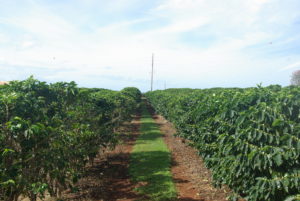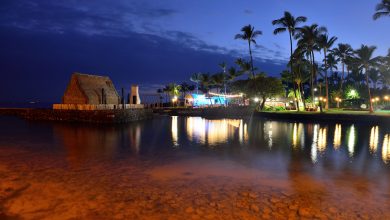
People often visit Hawaii to escape from it all, which makes perfect sense since the nearest landmass is over 2,000 miles away. However, that point is actually located in Alaska and not, as one might presume, California. The Hawaiian Islands are so isolated, in fact, that they have their own time zone. Maybe you knew that. But we bet you don’t know these seven other facts about our 50th state.

1. It’s One of Only Two States to Grow Coffee
With a coffee shop on nearly every corner it would be understandable to assume that a good many of the beans for these brews would be harvested on U.S. soil. However, that is not the case. Hawaii is one of only two states (along with California, to a much lesser extent) in the country to grow coffee beans commercially. Ideal growing conditions occur at high altitudes in tropical climates, evidenced by the island’s Kona “coffee belt”, a two-mile stretch of cropland 200 to 700 feet above sea level on Mauna Loa volcano.

The plant was first introduced to the islands in the early 1800s, though it wasn’t until the mid-19th Century that the industry would begin to flourish. At last count, Hawaii has been known to produce somewhere in the neighborhood of 10 million pounds of coffee annually, with just under 8,000 square acres of land dedicated to the fruit (yes, coffee beans are a fruit).

2. One of Its Islands Is Privately Owned
Once ruled by the Hawaiian monarchy, the 70-square mile island of Niihau was purchased by Elizabeth Sinclair back in 1864 for the tidy sum of ten thousand dollars. Known as the “Forbidden Island”, the land remains privately owned and is believed to be home to less than 50 residents, many of whom survive off welfare or by living off the land. In the past, the only visitors allowed to the island were relatives of the native Niihauans or of the Robinson family, the descendants of Ms. Sinclair. However, for the past decade, the owners of the island have offered limited access to outsiders in the form of helicopter tours that drop them off on the north shore and allow for more than three hours of exploration. These tours have helped fund a medevac chopper for the islanders, each of whom live in homes powered by solar energy and feature their own independent water systems.

3. It Is the Only State That Continues to Grow
Due to volcanic activity, the Hawaiian Islands (of which there are a whopping 137) continue to grow in acreage. At last count, its rate of expansion averaged 42 acres per year, thanks in large part to continuing eruptions from volcanoes such as Mount Kilauea on the Big Island. In 2018, after two months of continuous eruption, nearly 600 acres of land was added to the shoreline, just shy of a square mile. Though it will be quite a while before any of this new land is usable, the additional landmass becomes property of the Hawaiian government.

4. It’s Home to the Largest Pineapple Maze in the World
Dole Plantation, which offers a variety of tours and culinary experiences, is also home to the largest pineapple maze on the planet. Stretching more than three acres, the Pineapple Garden Maze boasts 14,000 plants that can be viewed from the two-and-a-half miles of pathways that visitors must navigate in order to emerge from this tropical labyrinth. A free downloadable app is available to supplement the experience by allowing guests to map out maze stations and track the time it takes them to complete this task. After wending their way through the maze, guests are welcome to stop by the Plantation Grille, where they can enjoy a variety of traditional island fare or indulge in one of the famous Dole Whips, a soft serve-like treat infused with refreshing pineapple flavor.

5. Snakes Are Banned in Hawaii
Enthusiasts of the slithering reptile may want to think twice before relocating to the islands, as snakes are illegal to own or import here. This is due in large part to the fact that there are no natural predators on the islands to help control the population, which could throw a huge monkey wrench into the food chain if certain species of snakes were ever introduced into the ecosystem. The chain of islands’ tropical environment would seem to be an ideal habitat for the cold-blooded creatures, but their presence would create competition for food as well as endanger the bird population by preying on them and their eggs. Illegal importation of these animals is punishable by a $200,000 fine, with the possibility of up to three years in prison. Something else that you won’t find on any of the islands; billboards. These larger-than-life advertisements are also banned, though presumably not because they eat birds.

6. It’s Home to Ten of the World’s Fourteen Climate Zones
The Köppen Climate Classification System was developed in 1884 by climatologist Wladimir Köppen, and today remains the standard when identifying climates throughout the world. Of the fourteen zones originally designated by Köppen’s criteria, the island of Hawaii features ten, ranging from tropical continuously wet to periglacial – which is characterized by cycles of thawing and refreezing and can be found at the summit of Mauna Kea. At just over 4,000 square miles, Hawaii is the only location in the world that can boast so many different and varying climates in such a relatively small area.

7. There Are No Private Beaches
Aside from select areas occupied by the Federal Government, there are absolutely no private beaches found among the Hawaiian Islands. Whereas in the past, some landowners would try to discourage visitors from accessing nearby beaches by disguising pathways, it is now illegal for them to do so. Though tourists are free to visit any beach, it is still recommended that they stick to the more established areas, as their waters are generally considered to be safer and are often overseen by lifeguards.




